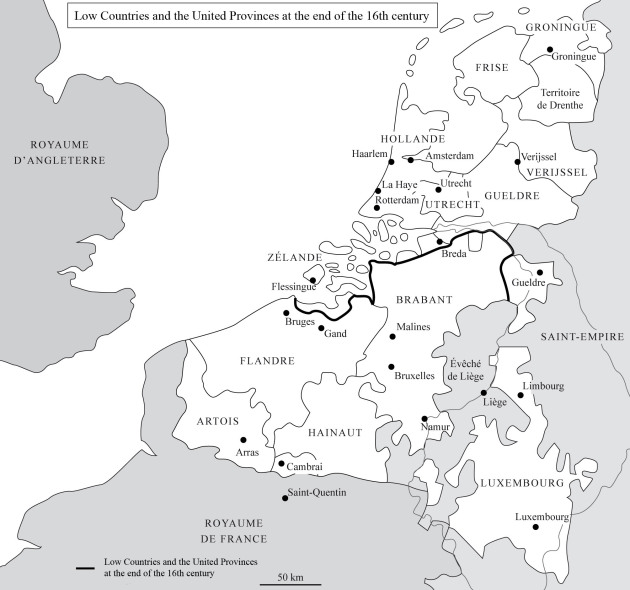The Low Countries : splitting into two states along faith lines
What was at the time known as the Low Countries was a very loose conglomerate of provinces covering territories spreading over the 21st century kingdoms of the Netherlands and Belgium, some regions of Northern France and the Grand-Duchy Luxembourg. Lutheran ideas rapidly seeped in via Antwerp, then Ghent and Bruges, rich trading cities in which new ideas readily spread about. With a difficult history behind them, these provinces were jealous of their freedoms and privileges harking back to the Middle Ages. There was no hint of centralisation in these regions; what bound them together was their common sovereign, Charles V. At the first whiff of Reformation in the region, he reacted very fast and very harshly, a thing easilier done here than in the Empire. In 1521, the first prohibitions, known as « placards »[1] were put out, giving notice of the refusal to seek any concord or to try reconciliation. Those introduced in the country a system modelled on the Spanish inquisition[2] which would nowhere else in Europe be applied with such ruthlessness. These persecutions did not much impede Lutheran then Calvinist advances, yet the populations bowed under persecution remained loyal to the Emperor. The situation was to change after Charles V's abdication. While entrusting the Empire to his brother Ferdinand, he passed the Low Countries on to his son Philip[3] who sought to handle the religious issue there with the most radical methods, declaring without demur that he would rather have the provinces emptied of their last inhabitants than finding them Protestant.
This policy brought about a general revolt and fighting for the Reformation overlapped for a while with fighting against Spain. This was to be William of Orange's[4] combat, as he attempted from 1576 to 1579 an approach far beyond the grasp of most of his contemporaries: bringing together under the same banner all the king of Spain's opponents without distinction of faith, in order together to exact from him the independence of the United Provinces. Riding on the brutality of Spanish oppression, he succeeded in joining for a while (1576-1579) Protestants and Catholic forces. No religious orthodoxy had as yet been imposed and Protestantism remained « fluid »
to quote Jonathan Israel an outstanding contemporary historian of that region. Furthermore the region's inhabitants had a visceral and ancient hatred of religious persecutions, at least as long as « heresies »
did not affect social order. Yet in 1579 the fragile arrangement unravelled. Religious tensions got the better of the situation: war-weary Southern provinces would make their peace with the king of Spain and would become, under the Habsburgs[5], a bastion of Counter-Reformation[6],while the United Provinces to the North would achieve independence and become 17th century Holland, one of the most powerful and dazzling states of Europe. Thus, here, a geographic and cultural unit split into two states of different religion.







